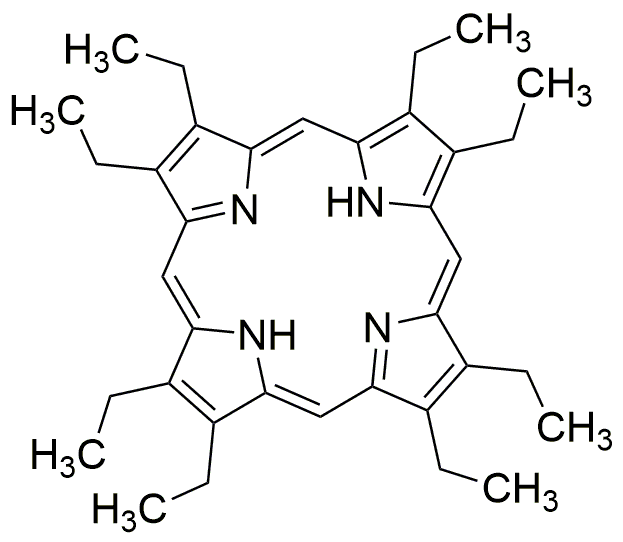2,3,7,8,12,13,17,18-Octaethylporphyrin is widely utilized in research focused on:
- Photodynamic Therapy: This compound is used in cancer treatment, where it acts as a photosensitizer. When exposed to light, it generates reactive oxygen species that can destroy cancer cells, making it a valuable tool in targeted therapy.
- Solar Energy Conversion: Its unique structure allows it to efficiently absorb sunlight, making it an excellent candidate for use in solar cells. Researchers are exploring its potential to enhance the efficiency of photovoltaic devices.
- Biochemical Sensors: The compound can be incorporated into sensors for detecting various biomolecules. Its ability to change properties in response to environmental changes makes it useful in medical diagnostics and environmental monitoring.
- Organic Electronics: It is being studied for applications in organic light-emitting diodes (OLEDs) and organic photovoltaics, where its electronic properties can improve device performance and stability.
- Catalysis: The compound shows promise as a catalyst in various chemical reactions, particularly in organic synthesis. Its unique porphyrin structure can facilitate reactions that are challenging with traditional catalysts.
Información general
Propiedades
Seguridad y normativas
Aplicaciones
2,3,7,8,12,13,17,18-Octaethylporphyrin is widely utilized in research focused on:
- Photodynamic Therapy: This compound is used in cancer treatment, where it acts as a photosensitizer. When exposed to light, it generates reactive oxygen species that can destroy cancer cells, making it a valuable tool in targeted therapy.
- Solar Energy Conversion: Its unique structure allows it to efficiently absorb sunlight, making it an excellent candidate for use in solar cells. Researchers are exploring its potential to enhance the efficiency of photovoltaic devices.
- Biochemical Sensors: The compound can be incorporated into sensors for detecting various biomolecules. Its ability to change properties in response to environmental changes makes it useful in medical diagnostics and environmental monitoring.
- Organic Electronics: It is being studied for applications in organic light-emitting diodes (OLEDs) and organic photovoltaics, where its electronic properties can improve device performance and stability.
- Catalysis: The compound shows promise as a catalyst in various chemical reactions, particularly in organic synthesis. Its unique porphyrin structure can facilitate reactions that are challenging with traditional catalysts.
Documentos
Hojas de datos de seguridad (HDS)
La SDS proporciona información de seguridad completa sobre la manipulación, el almacenamiento y la eliminación del producto.
Especificación del producto (PS)
La PS proporciona un desglose completo de las propiedades del producto, incluida la composición química, el estado físico, la pureza y los requisitos de almacenamiento. También detalla los rangos de calidad aceptables y las aplicaciones previstas del producto.
Certificados de análisis (COA)
Busque certificados de análisis (COA) ingresando el número de lote del producto. Los números de lote y de partida se pueden encontrar en la etiqueta de un producto después de las palabras "Lote" o "Lote".
Número de catálogo
Número de lote/lote
Certificados de origen (COO)
Este certificado de origen confirma el país en el que se fabricó el producto y también detalla los materiales y componentes utilizados en él y si se deriva de fuentes naturales, sintéticas u otras fuentes específicas. Este certificado puede ser necesario para cumplir con las normativas aduaneras, comerciales y regulatorias.
Número de catálogo
Número de lote/lote
Hojas de datos de seguridad (HDS)
La SDS proporciona información de seguridad completa sobre la manipulación, el almacenamiento y la eliminación del producto.
DownloadEspecificación del producto (PS)
La PS proporciona un desglose completo de las propiedades del producto, incluida la composición química, el estado físico, la pureza y los requisitos de almacenamiento. También detalla los rangos de calidad aceptables y las aplicaciones previstas del producto.
DownloadCertificados de análisis (COA)
Busque certificados de análisis (COA) ingresando el número de lote del producto. Los números de lote y de partida se pueden encontrar en la etiqueta de un producto después de las palabras "Lote" o "Lote".
Número de catálogo
Número de lote/lote
Certificados de origen (COO)
Este certificado de origen confirma el país en el que se fabricó el producto y también detalla los materiales y componentes utilizados en él y si se deriva de fuentes naturales, sintéticas u otras fuentes específicas. Este certificado puede ser necesario para cumplir con las normativas aduaneras, comerciales y regulatorias.


